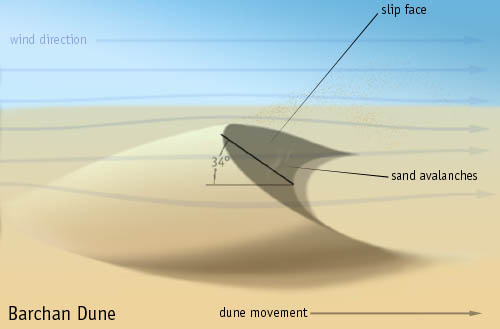 |
|
Le Musée de Sainville
|
Wind-driven transport and deposition of sand is called an "aeolian process".Aeolian processes occur in deserts and on beaches, or wherever there are granular materials and strong enough winds to move the particles.
The transport of sand is a function of particle size and wind velocity.
“Air, I should explain, becomes wind when it is agitated.”Sand blowing off a dune crest is shown in an image below of the Kelso Dunes.
― Lucretius (99 BC – c. 55 BC), On the Nature of Things
|
image by Mark A. Wilson
|
 Sand is moved by the wind via
Sand is moved by the wind via- Suspension (fine particles);
- Saltation (the skipping of medium-sized particles); or
- Creep (the rolling or sliding large-sized particles).
- Sand sheets;
- Ripples; or
- Dunes.
Sand sheets are gently undulating sandy areas. Ripples occur when wind blows surface materials into crests and troughs. The long axes of the crests and troughs are perpendicular to the direction of the wind.
 |
|
image by Charles O'Rear
|
Dunes are accumulations of sand blown into mounds or ridges. The windward side of a dune has a gentle slope. The lee side, or the downwind portion of the dune, has a steeper avalanche slope called a slip face or Barchan dune.
REFERENCES
- Aeolus, Wikipedia.
- Aeolian Processes, Wikipedia.
- Sand Dunes: Amazing and Mysterious, Discovery News, 16 June 2015.
- The physics of wind-blown sand and dust, Kok J F, Parteli E J R, Michaels T I and Bou Karam D 2012. Phys. 75 106901.




